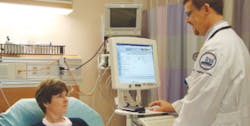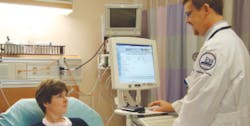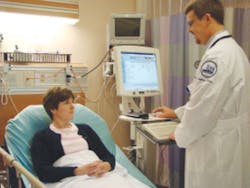Electronic health-record implementation provides dramatic productivity improvements, $600,000 in annual savings, and a return on investment of slightly more than two years.
Electronic health-record implementation provides dramatic productivity improvements, $600,000 in annual savings, and a return on investment of slightly more than two years.
A few years ago, Robert Carroll, M.D., the chairman of emergency medicine and medical director at Eastern Connecticut Health Network (ECHN), took a step back from a day of controlled chaos and realized he needed a better way to gather data that would identify bottlenecks in his emergency departments (EDs). At the time, the staff used paper forms and charts to treat and track patients, and paper was not pulling its weight.
The emergency departments at the two hospitals of ECHN together handle an average of 180 patients a day and more than 68,000 visits a year. The 249-bed Manchester Memorial Hospital and 102-bed Rockville General Hospital are affiliates of ECHN, a not-for-profit, community-based health system serving residents of 19 towns in eastern Connecticut.
“We spent an enormous amount of time trying to find treatment forms and figure out where paper charts were,” says Carroll. “The only way I could really gauge our caseload was by looking at the chart rack and seeing how many patient charts were there waiting to be seen. We didn’t have the real-time data to show how many patients we had in the ED, and therefore were limited in our ability to make decisions about how we could treat them more efficiently.”
An analysis of patient throughput revealed how broken processes were creating barriers to patient care. About 90 minutes were needed from the time a patient came through the doors until she was seen by a physician. In addition, the entire throughput time was about four-and-a-half-hours, Carroll says.
ECHN already had an inpatient electronic health-records (EHR) system implemented at its two acute-care hospitals. The ED staff was adamant, however, that the inpatient EHR was not suited for their environment. So, after extensive research and site visits to observe three different products in action, ECHN purchased the Allscripts ED electronic-records system.
“The decision of our selection committee, which included doctors, nurses and IT staff, was unanimous,” says Carroll. “The results we’ve seen since then have proven that assumption to be true.”
The software has helped ECHN improve its ED operations dramatically, he says. Physicians now are able to get workups started and tests ordered while patients are still in the waiting room. The “door-to-doc” time has been reduced to 37 minutes at Manchester Memorial and 29 minutes at Rockville General. Throughput time has been cut nearly in half, to two-and-a-half hours.
In addition, ECHN has saved about $600,000 per year by eliminating dictation and transcription costs. Those savings enabled ECHN to pay back the cost of the system in slightly more than two years.
Interfaces Tricky, Time Consuming
Pushing the inpatient EHR system into the emergency departments would have been easier and less expensive, says Nancy Lester, RN, clinical systems analyst at ECHN. “But we needed more than it had to offer.”
Building interfaces between the two systems was tricky and time consuming, she explains. ECHN broke new ground by creating several new interfaces that had never been used before to connect the two systems. The critical needs of the emergency departments trumped the integration drawbacks, Lester adds.
“Emergency departments are truly unique environments, and we simply could not mold the enterprise EHR into a form that would meet the needs of ED caregivers,” she says. “We decided to go with Allscripts because it was user-friendly and easily customizable.”
A key feature of the software is the “tracking board” that mimics traditional grease boards used in many EDs. The tracking board, which is identical on all the desktop computers and computers on wheels used in the EDs, lists all the patients in the emergency department – whether they are in the waiting room, in front of a triage nurse or being treated by a physician.
Next to each patient’s name is a series of icons that link to treatment information entered at the point of care by ED staff. When the cursor is hovered over an icon, a box of information pops up that explains treatments administered and tests that have been ordered, as well as lab results and other clinical data collected during treatment.
“The intuitive design of the tracking board is critical for our emergency departments,” Lester says. “We can assign access privileges to respiratory therapists, psychiatric evaluators, hospitalists and attending physicians, and they can easily navigate the system and gather needed information without any assistance.”
The tracking board has eliminated many roadblocks caregivers faced when trying to collaborate on patient treatment, Carroll says. In a paper environment, physicians and others had to wait until one caregiver documented treatment, then hunt down the paper forms before administering care.
“It was extremely frustrating not being able to simultaneously view information and share data with multiple caregivers,” Carroll says. “The biggest change in patient treatment is that information is now being pushed to us, rather than us having to pull data from paper forms or the enterprise EHR. For example, when I order a blood test, the results are pushed back to me via an icon that pops up on the screen. I don’t have to go find that information anymore.”
Treatment Bottlenecks Identified
In addition, the productivity data provided by the application was the impetus behind the process improvements achieved by the EDs. Tracking every patient from when they walk into the ED has enabled Carroll and his peers to identify bottlenecks.
The data led to a reshuffling of staffing levels in the EDs. More mid-level providers were added to treat the volume of non-critical cases, which freed physicians to focus more on critical cases, Carroll says.
The ability to customize the software on the fly was the other key feature of the application, Lester says. The software’s architecture makes designing the user screens simple. Just as importantly, screens can be adjusted to incorporate alerts for mandatory information, such as family and social history, and make capturing all the core elements needed for documentation and coding easier. Adjustments also can be made to comply with the ever-changing regulatory reporting requirements from state, federal and accreditation agencies, Lester says.
“Medicare, Medicaid and the Joint Commission change reporting requirements on an almost monthly basis,” she says. “I can devise changes to documentation screens and put them in place in a matter of hours, instead of having to request changes from a vendor and possibly go through a lengthy and/or expensive process.”
The most challenging part of the implementation was interfacing with the inpatient EHR system, from Westwood, Mass.-based Medical Information Technology (MEDITECH). The goal was to ensure that data from the Allscripts ED flowed seamlessly into the inpatient EHR to ensure care continuity when a patient was transferred from the ED to a patient floor at the hospital.
The toughest task turned out to be sending medication orders from Allscripts to the inpatient EHR. ECHN wanted all the granular information medications administered in the ED to be available for hospital clinicians, including drug profile, dosage and administration method, and specific “if/or” questions related to administration. The chief obstacle was that the inpatient EHR contained proprietary programming and unique “flavors” of Health Level 7 messaging standards.
Today, the interface delivers significant clinical benefits, according to Carroll. Allergies, current medications and family histories can be exchanged from the application to the inpatient EHR and are available in real time. In addition, the entire care record from the ED is uploaded to the inpatient EHR when a patient is discharged from the emergency department.
From the Catalog
According to www.allscripts.com : Allscripts ED uses leading-edge Windows technology to maximize functionality and create an easy-to-use environment for emergency department (ED) clinicians and staff. The solution uses Web-based and client-server technologies, and offers a broad range of systems options and interface capabilities. Allscripts ED is CCOW-compliant, allowing clinical applications to share information at the point of care. Allscripts ED is built on standard programming languages, operating systems, databases and network protocols.
For more information on
Allscripts solutions:
www.rsleads.com/912ht-200




